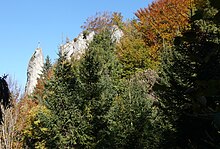Opponitz formation

The Opponitz Formation is a lithostratigraphic formation of the Upper Triassic of the Northern Limestone Alps . It is underlain by the Lunz Formation and the Reingraben Formation and overlaid by the main dolomite formation . It is dated to the late Karn ( Tuval ).
The type locality of the formation is at Opponitz in the Ybbstal , its first description comes from Marko Vincenc Lipold .
description
The Opponitz lineup consists mainly of well stratified limestones and often powerful, plaster - and anhydrite leading Rauwackenhorizonten in the footwall and hanging wall . In addition, dolomites , marls and shale clays are found locally . These rocks were formed from muddy sediments under very salty conditions. The limestones are originally micrite , which have partially recrystallized to microparit and sparit . The Opponitz Formation occurs in the eastern part of the Northern Limestone Alps, in the Lunz facies area . It is up to 300 meters thick.
Fossil guide
The rocks of the Opponitz Formation are relatively poor in fossils because the salty muds are likely to have been hostile to life. In some places mussel beds with bivalves could be found. There are also mussel crabs (ostracods), snails (gastropods), foraminifera and crinoids , and there are local sea urchin spines .
geomorphology


In the landscape, the transition from the Lunz strata to the Opponitz strata is associated with a major change in many places. While there are gentle meadow areas on the easily erodible Lunz strata, the Opponitz strata stand out due to their steeper terrain and rock faces.
Storage rock
The rocks of the Opponitz Formation, together with the main dolomite in the underground of the Vienna Basin, represent storage rocks for natural gas. The Opponitz Rauwacken are good drinking water reservoirs, so Weyer and Waidhofen an der Ybbs get their drinking water for the most part from the Opponitz Rauwacken.
See also
Individual evidence
- ↑ Alexander Tollmann: Geology of the limestone foothills in the Ötscherland as an example of alpine tectonics. In: Communications from the Geological Society in Vienna. Volume 58, 1965, p. 130 ( PDF file , accessed June 20, 2006).
- ↑ Christoph Janda: Geological - facial investigations in the Lunzer ceiling southwest of Weyer (Upper Austria). Diploma thesis, Vienna 2000, pp. 47–52 ( PDF file , univie.ac.at, accessed on June 20, 2009).
- ^ A b Johann Georg Haditsch: Celestine and fluorspar from the Opponitz limestone of Obermicheldorf / Upper Austria. In: Yearbook of the Upper Austrian Museum Association. 112a, 1967, pp. 161–172 ( PDF on ZOBODAT , accessed June 20, 2009).
- ^ Rudolf Oberhauser, Franz Karl Bauer: The geological structure of Austria. Springer-Verlag, Vienna 1980, ISBN 978-3-211-81556-4 , p. 223 ( limited preview in the Google book search).
- ↑ Alexander Tollmann: Analysis of the classical North Alpine Mesozoic. Stratigraphy, fauna and facies of the Northern Limestone Alps. Part II of the monograph of the Northern Limestone Alps, Verlag Deuticke, Vienna 1976, p. 150.
- ↑ ops.cit. Oberhauser, Bauer, 1980, p. 26 ( limited preview in Google book search).
- ^ Thomas Hornung, The 'Carnian Crisis' in the Tethys realm: multistratigraphic studies and paleoclimate constraints. Dissertation, Innsbruck 2007, p. 150.
- ↑ a b Erich Thenius: Lower Austria. Geology of the Austrian federal states in brief individual representations. 2nd expanded edition, Vienna 1974, p. 119 f.
- ↑ Peter Masaryk, Otilia Lintnerova: Diagenesis and Porosity of the Uppber Triassic carbonate of the pre-Neogene Vienna Basin Basement. In: Geology Carpathica. Volume 48, 6/1997, pp. 371-386 ( abstract , geologicacarpathica.sk, accessed June 20, 2009).
- ↑ ops.cit. Janda 2000, p. 52.